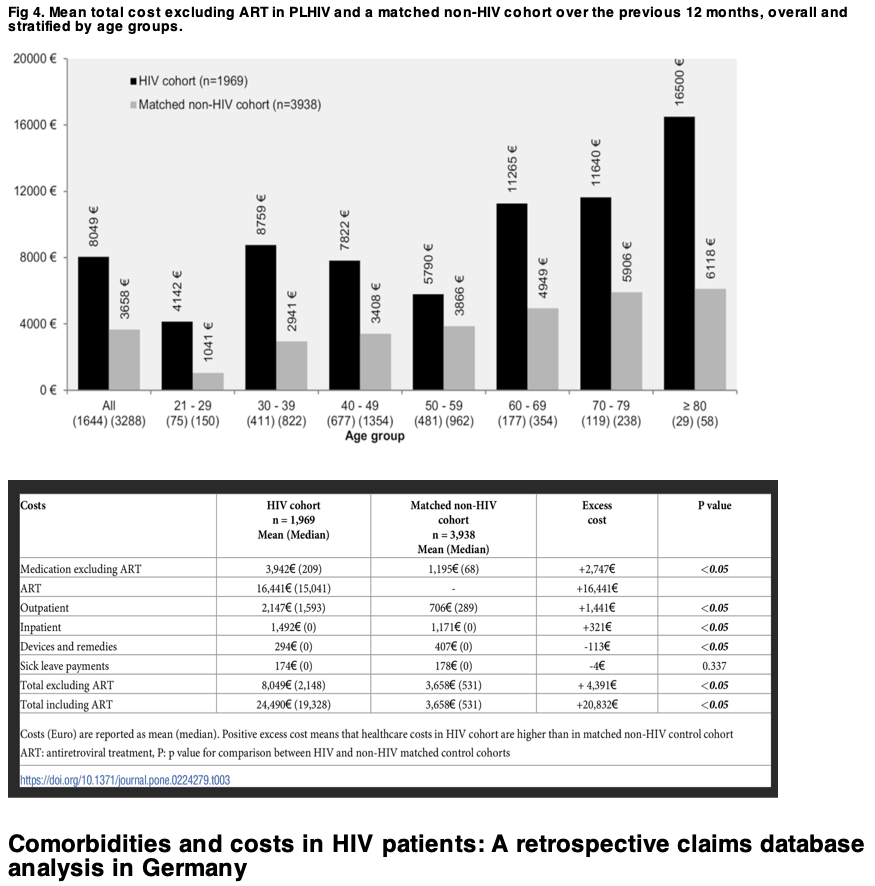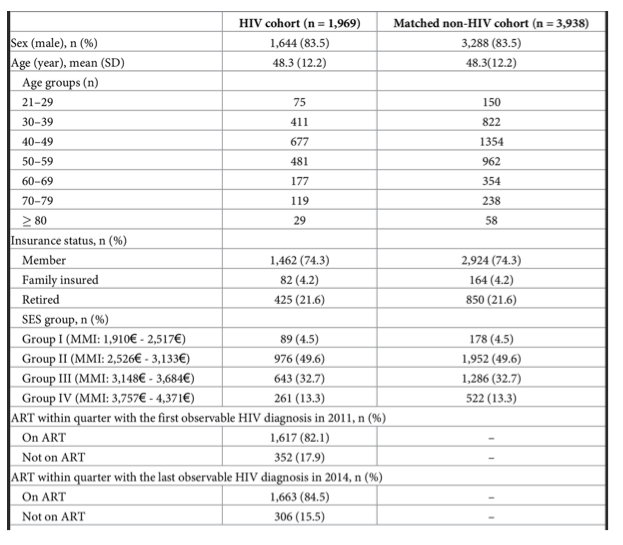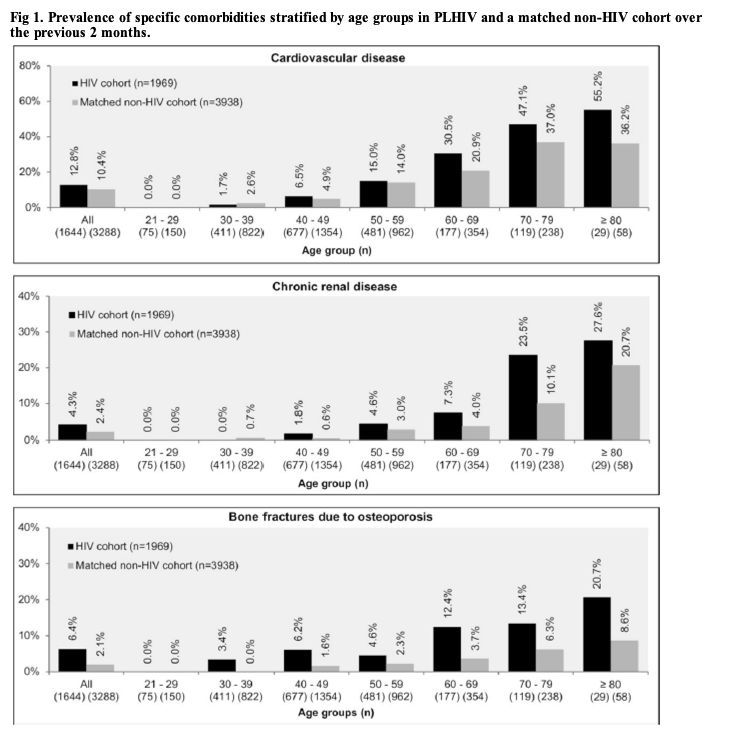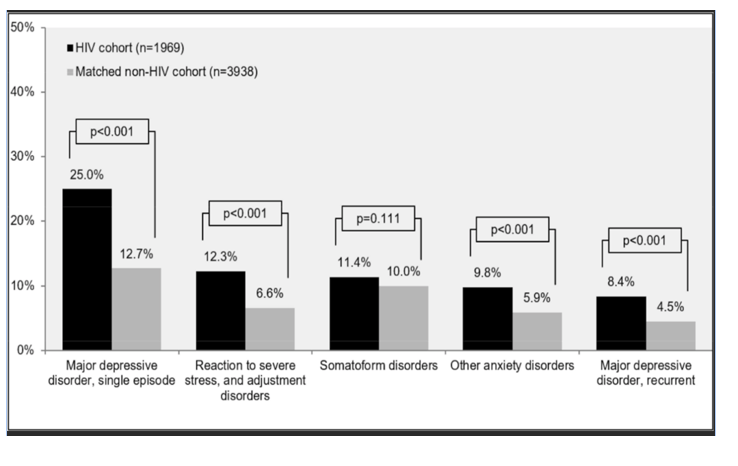| |
Increased Healthcare Costs for Older HIV+
|
| |
| |
Download the PDF here
https://journals.plos.org/plosone/article?id=10.1371/journal.pone.0224279
"Overall, the excess costs reported in this study potentially reflect the higher burden of comorbidities among PLHIV."
"Our findings suggest that HIV remains an area of high unmet medical need demanding further research on disease management in aging populations. To improve patient outcomes and reduce the economic burden of HIV, it is crucial to better understand how the selection of ART can have an impact on comorbidities and how to better manage comorbidities throughout the life course of PLHIV."
this study demonstrated that healthcare costs unrelated to ART incurred by HIV patients in a one-year timeframe exceeded costs incurred by the matched control cohort by approximately 4,400€, with even greater differences in older age groups. These results support findings by Quiros-Roldan and colleagues (2016), who found that HIV infection ranked as the third most costly chronic disease in a North Italian population in 2014 with 9-fold increased per capita costs compared to the overall non-matched population [5].
In this study, HIV patients had a higher prevalence of CVD, HBV and HCV infections, acute and chronic renal disease, bone fractures due to osteoporosis, single episode or recurrent major depressive disorders, adjustment disorders, and other anxiety disorders compared to matched patients from a representative sample of the general population in Germany. The findings of this matched cohort analysis indicated a premature onset of non-HIV related comorbidities in PLHIV, corroborating other studies [11-16]. Additionally, the current study findings extend work by Quiros-Roldan and colleagues (2016) in Italy, which suggested an increased prevalence of most chronic diseases across time, including serious psychiatric diseases [5]. A review by Nanni and colleagues (2015) further suggests a two- to four-fold increase in the prevalence of major depression compared with non-HIV infected patients [17], in line with the findings of our analysis, showing almost double the prevalence of major depressive disorders (25% HIV-cohort vs. 13% non-HIV cohort, p<0.001).
PLHIV face a higher risk for non-HIV related comorbidities such as cardiovascular diseases (CVD), renal failure and bone fractures [2], particularly at older ages. In addition to age, certain ART regimens may influence or favour the progress of such comorbidities. The expected increased burden of non-communicable diseases along with a prolonged life expectancy of PLHIV entails greater use of healthcare resources, especially medications [4]. Quiros-Roldan and colleagues reported that HIV-infected patients, on average, had one or more chronic diseases in addition to HIV, compared to the general population in Italy [5]. Kidney failure, psychiatric diseases and cancer were reported as the most expensive comorbidities with substantially higher per capita costs [5].
The majority of mental illnesses and behavioural disorders such as major depressive disorder (either as a single episode or recurrent), adjustment disorders (including reaction to severe stress) and other anxiety disorders occurred significantly more often in the HIV cohort than in the matched control cohort.
The prevalence of acute renal disease (0.5% vs. 0.2%, p = 0.045), bone fractures due to osteoporosis (6.4% vs. 2.1%, p<0.001), chronic renal disease (4.3% vs. 2.4%, p<0.001), CVD (12.8% vs. 10.4%, p = 0.006), HBV infection (5.9% vs. 0.3%, p<0.001) and HCV infection (8.8% vs. 0.3%, p<0.001) were significantly higher in the HIV cohort than in the matched non-HIV control cohort (Table 2). Prevalence of CVD, chronic renal disease and bone fractures due to osteoporosis were higher at older ages in both the HIV and matched non-HIV cohort. CVD, chronic renal disease, and bone fractures due to osteoporosis were more prevalent in the HIV cohort
Healthcare costs
Table 3 presents the mean total, non-ART, healthcare costs per patient comparing the HIV cohort with the matched non-HIV cohort. In total, mean costs (not related to ART) were significantly higher in the HIV cohort than in the non-HIV matched control cohort (8,049€ vs. 3,658€, p<0.05). The same pattern was observed across age groups. In each age group, the mean costs (not related to ART) were higher in the HIV cohort compared to the non-HIV matched control cohort. In absolute numbers, PLHIV aged 80 years or older (+10,382€) had the highest excess cost. In relation to the mean costs in the control cohort, PLHIV in younger age groups (4-fold increase and 3-fold increase for PLHIV aged 21-29 years and 30-39 years, respectively) and in the oldest age group (3-fold increase for PLHIV aged 80 years or older) had the highest excess cost compared to the middle-aged groups (1 to 2-fold increase) (Fig 4).
When ART costs of 16,441€ were included, mean total costs were 24,490€ in the HIV cohort and 3,658€ in the matched control cohort, amounting to an excess cost of 20,832€ in the HIV cohort (p<0.05) (Table 3).
Aside from ART, non-ART medication costs, and outpatient and inpatient costs were the main cost drivers among HIV patients, who had significantly higher costs than the matched control cohort (Table 3). On average, PLHIV incurred excess costs of 2,747€ for pharmaceuticals excluding ART (p<0.05), 1,441€ for outpatient care (p<0.05) and 321€ for inpatient care (p<0.05). Costs for devices and remedies were significantly higher in the non-HIV control cohort, with excess costs of 113€ (p<0.05).

PLOS November 6, 2019 - Stefan Christensen1,2, Eva Wolf3, Julia AlteversID4*, Helena Diaz-Cuervo51 Center for Interdisciplinary Medicine (CIM) InfectiousDiseases, Muenster, Germany,2 Department of Gastroenterology and Hepatology, Muenster University Hospital ,Muenster, Germany,3MUC Research, Munich,Germany,4X cenda GmbH, Hannover, Germany,5 Gilead Sciences Europe, GreaterLondon, UnitedKingdom
Abstract
People living with human immunodeficiency virus (PLHIV) are at high risk of developing non-HIV related comorbidities, particularly at older ages. In a retrospective claims database analysis, we compared PLHIV to a matched, non-HIV cohort to assess the prevalence of comorbidities and healthcare costs in PLHIV and the general non-HIV population in Germany. In total, 2,132 adult patients with HIV were identified in the InGef research database with HIV ICD-10 diagnosis within each year from 2011 to 2014. Of these, 1,969 could be matched to a control cohort of 3,938 individuals (1:2 ratio). Matching criteria included age, gender and socio-economic variables. The prevalence of acute renal disease (0.5% vs. 0.2%, p = 0.045), bone fractures due to osteoporosis (6.4% vs. 2.1%, p<0.001), chronic renal disease (4.3% vs. 2.4%, p<0.001), cardiovascular disease (12.8% vs. 10.4%, p = 0.006), Hepatitis B (5.9% vs. 0.3%, p<0.001) and Hepatitis C infection (8.8% vs. 0.3%, p<0.001) was significantly higher in PLHIV compared to the matched non-HIV cohort. Mean costs excluding costs for antiretroviral therapy (ART) were significantly higher in the HIV cohort (8,049€ vs. 3,658€, p<0.05). On average, PLHIV incurred excess costs of 16,441€ for ART, 2,747€ for pharmaceuticals excluding ART (p<0.05), 1,441€ for outpatient care (p<0.05) and 321€ for inpatient care (p<0.05). Devices and remedies' costs were significantly higher in the control cohort with excess costs of 113€ (p<0.05). Considering mean total costs, excluding ART, excess costs for PLHIV amounted to 8,049€ (p<0.05). This analysis demonstrated an increased comorbidity and economic burden of PLHIV compared to matched controls. Our findings suggest that HIV remains an area of high unmet medical need. To improve patient outcomes, adequate HIV management including regular monitoring, screening for comorbidities and optimal ART selection throughout the life course of PLHIV are of key importance.
Before matching, patients in the HIV cohort were on average younger, with a mean age of 48.3 years compared to 52.3 years in the non- HIV cohort from the general population. The HIV cohort also had a considerably higher proportion of men than the non-HIV cohort (82.6% compared to 48.5%).

Specific comorbidities
The prevalence of acute renal disease (0.5% vs. 0.2%, p = 0.045), bone fractures due to osteoporosis (6.4% vs. 2.1%, p<0.001), chronic renal disease (4.3% vs. 2.4%, p<0.001), CVD (12.8% vs. 10.4%, p = 0.006), HBV infection (5.9% vs. 0.3%, p<0.001) and HCV infection (8.8% vs. 0.3%, p<0.001) were significantly higher in the HIV cohort than in the matched non-HIV control cohort (Table 2). Prevalence of CVD, chronic renal disease and bone fractures due to osteoporosis were higher at older ages in both the HIV and matched non-HIV cohort. CVD, chronic renal disease, and bone fractures due to osteoporosis were more prevalent in the HIV cohort compared to the matched non-HIV control cohort, following a similar trend among the different age groups (Fig 1). Despite the higher CVD prevalence in HIV patients, the prevalence of hypertension (primary or secondary) was significantly higher in matched controls (29.3% vs. 32.6%, p = 0.010).

The 50 most common comorbidities
Among the most frequent comorbidities in PLHIV and the matched non-HIV cohort were dorsalgia, primary hypertension, acute upper respiratory infections and disorders of lipoprotein metabolism, including dyslipidemia and other lipidemias. However, the prevalence of these comorbidities differed significantly in the two cohorts, except for disorders of lipoprotein metabolism (20.1% HIV vs 22.3% non-HIV, p = 0.057), with higher prevalence in the matched control group of dorsalgia (25.6% vs 29.4%, p = 0.002) and primary hypertension (24.8% vs 29.6%, p<0.001), and higher prevalence in PLHIV of acute upper respiratory infections (20.6% vs 15.5% p<0.001, Fig 2).
Furthermore, mental disorders greatly differed between the HIV and matched non-HIV cohorts. The majority of mental illnesses and behavioural disorders such as major depressive disorder (either as a single episode or recurrent), adjustment disorders (including reaction to severe stress) and other anxiety disorders occurred significantly more often in the HIV cohort than in the matched control cohort. Additionally, somatoform disorders were observed more frequently among PLHIV than in the matched non-HIV cohort, although differences were not statistically significant (Fig 3).

Healthcare costs
Table 3 presents the mean total, non-ART, healthcare costs per patient comparing the HIV cohort with the matched non-HIV cohort. In total, mean costs (not related to ART) were significantly higher in the HIV cohort than in the non-HIV matched control cohort (8,049€ vs. 3,658€, p<0.05). The same pattern was observed across age groups. In each age group, the mean costs (not related to ART) were higher in the HIV cohort compared to the non-HIV matched control cohort. In absolute numbers, PLHIV aged 80 years or older (+10,382€) had the highest excess cost. In relation to the mean costs in the control cohort, PLHIV in younger age groups (4-fold increase and 3-fold increase for PLHIV aged 21-29 years and 30-39 years, respectively) and in the oldest age group (3-fold increase for PLHIV aged 80 years or older) had the highest excess cost compared to the middle-aged groups (1 to 2-fold increase) (Fig 4).
Discussion
In this study, HIV patients had a higher prevalence of CVD, HBV and HCV infections, acute and chronic renal disease, bone fractures due to osteoporosis, single episode or recurrent major depressive disorders, adjustment disorders, and other anxiety disorders compared to matched patients from a representative sample of the general population in Germany. The findings of this matched cohort analysis indicated a premature onset of non-HIV related comorbidities in PLHIV, corroborating other studies [11-16]. Additionally, the current study findings extend work by Quiros-Roldan and colleagues (2016) in Italy, which suggested an increased prevalence of most chronic diseases across time, including serious psychiatric diseases [5]. A review by Nanni and colleagues (2015) further suggests a two- to four-fold increase in the prevalence of major depression compared with non-HIV infected patients [17], in line with the findings of our analysis, showing almost double the prevalence of major depressive disorders (25% HIV-cohort vs. 13% non-HIV cohort, p<0.001).
Our analysis suggests that HIV patients generally have higher CVD rates. Across age groups older than 40 years, CVD was more prevalent in PLHIV compared to the matched cohort. CVD prevalence increased markedly with age among PLHIV compared to matched controls. However, significantly fewer PLHIV presented with hypertension than their matched controls. In contrast to our findings, Triant and colleagues (2007), who compared acute myocardial infarction rates and cardiovascular risk factors in HIV-infected to non-HIV-infected individuals from two Boston healthcare facilities, found a significantly higher proportion of patients with hypertension in HIV participants compared to non-HIV [18]. Similarly, in the present study rates for diabetes mellitus and dyslipidaemia were comparable between the HIV cohort and matched control cohort, whereas Triant and colleagues found that the proportion of PLHIV having each of these comorbidities was significantly higher [18]. Different databases (registry vs. claims data), countries (Unites States of America vs. Germany), study periods (1996-2004 vs. 2011-2014) and different patient characteristics as well as the evolution of ART with fewer long-term side effects may account for these conflicting findings. Diabetes mellitus and dyslipidaemia were similar in PLHIV and matched non-HIV controls which aligns with Freiberg and colleagues' findings (2013) that HIV itself is associated with increased risk for CVD beyond that explained by other recognized risk factors [19].
Brown and colleagues (2006) assessed the prevalence estimates of osteopenia and osteoporosis in HIV-infected individuals within a meta-analytic review. Out of 884 HIV-infected individuals, 67% had reduced bone mineral density, of whom 15% had osteoporosis. Furthermore, HIV-infected patients had 6.4-fold increased odds of reduced bone mineral density (95% confidence interval, CI, 3.7-11.3) and 3.7-fold increased odds of osteoporosis (95% CI 2.3-5.9) [20]. These findings are in line with the present study, showing a prevalence of 6.4% for bone fractures due to osteoporosis (wrist, shoulder, hip, and spine) for the HIV cohort compared to 2.1% in the control cohort.
In our study, 4.4% of the HIV cohort presented with chronic renal disease, compared to 2.4% in the matched control cohort; chronic renal disease was very common in older patients, with almost a quarter of PLHIV aged 70 and older suffering from this disease. These results support those by Althoff and colleagues (2015), who compared the risk and age at diagnosis of myocardial infarction and end-stage renal disease (ESRD) in a large sample of 97,922 patients (N = 30,243 with HIV) of the Veterans Aging Cohort Study of HIV-infected and demographically matched uninfected veterans seen between April 2003 to December 2010; while 7% of PLHIV presented with ESRD, only 5% of patients without HIV experienced ESRD (p<0.001) [21].
In the years following the study period from 2011 to 2014 included in this analysis, new treatment options for HIV have been introduced to the German market with the aim of regimen simplification and reduction of long-term toxicities including single tablet triple combinations with tenofovir alafenamide (TAF) and/or second generation integrase inhibitors such as bictegravir or dolutegravir as well as single tablet dual combinations such as dolutegravir and rilpivirine. Similar to TDF, TAF is a prodrug of tenofovir but was shown to have an improved safety profile. Multiple studies demonstrated that TAF had a reduced impact on renal function and bone mineralization in comparison to TDF [22]. The single tablet combination dolutegravir and rilpivirine was also shown to significantly improve bone mineral density and bone turnover markers when compared to TDF-based three-drug regimens [23]. In due consideration of these new treatment options, the rate of PLHIV on ART developing renal disease or osteoporosis may have decreased by now. However, this study captured comorbidities through 2014 and could form the basis and additionally guide future studies, particularly as PLHIV age and experience a higher burden of age-related comorbidities. Further studies are needed to reflect the current situation and possibly assess any potential changes in comorbidity prevalence among these patients.
Furthermore, this study demonstrated that healthcare costs unrelated to ART incurred by HIV patients in a one-year timeframe exceeded costs incurred by the matched control cohort by approximately 4,400€, with even greater differences in older age groups. These results support findings by Quiros-Roldan and colleagues (2016), who found that HIV infection ranked as the third most costly chronic disease in a North Italian population in 2014 with 9-fold increased per capita costs compared to the overall non-matched population [5].
Overall, the excess costs reported in this study potentially reflect the higher burden of comorbidities among PLHIV.
Limitations
In general, administrative data are primarily collected for accounting purposes and not for clinical or research purposes. Thus, clinical parameters such as laboratory test results as well as the actual medication intake by the patient or the dosage of medications were not covered by the database. Also, the indication for the prescription was not captured. Lifestyle factors with a potential impact on medication use such as unhealthy diet or drug consumption were not available in the database. Additionally, other important cost categories (e.g. indirect costs such as the cost of workdays lost) are difficult to assess with claims data, as this information is only available for health insurance members but not for family members that are covered free of charge by the health insurance policy. As the data was from a SHI perspective, private sector data was unavailable, which could have resulted in an underestimation of the (excess) costs.
In the matching process, it cannot be ruled out that unobserved variables were unequally distributed in both groups, leading to biased results. In addition, since adequate matches could not be found for 6.5% of the eligible HIV patients, the study results might be not representative of the entire population with HIV. Furthermore, place of residence on a district level might be an inadequate proxy for SES, since it is an aggregate measure and does not necessarily reflect individual SES. Moreover, PLHIV have a higher risk behaviour regarding sexually transmitted diseases compared to the general population, which was not considered in the matching and therefore may lead to biased results in terms of costs [24-26].
Conclusions
This retrospective German claims data analysis demonstrated the increased comorbidity and economic burden of PLHIV compared to individuals from the general population with similar characteristics. PLHIV faced a higher risk of CVD, HBV and HCV infections, acute and chronic renal disease, bone fractures due to osteoporosis, and mental disorders, with an earlier onset of these conditions in PLHIV.
The advanced treatment options of ARTs improve the life expectancy of PLHIV. However, when comparing HIV patients to a cohort of patients of similar characteristics not affected by HIV, these patients seem to be more prone to age-related comorbidities.
Our findings suggest that HIV remains an area of high unmet medical need demanding further research on disease management in aging populations. To improve patient outcomes and reduce the economic burden of HIV, it is crucial to better understand how the selection of ART can have an impact on comorbidities and how to better manage comorbidities throughout the life course of PLHIV.
|
|
| |
| |
|
|
|